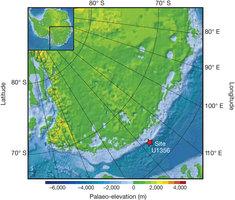Tropical climate in the Antarctic
Computer models indicate that future climate warming will be particularly pronounced in high-latitude regions, i.e., near the poles. Until now, however, it has been unclear how Antarctic terrestrial ecosystems responded in the geological past to a greenhouse climate with high atmospheric CO2 concentrations.
The scientists working with Prof. Pross analysed rock samples from drill cores on the seabed, which were obtained off the coast of Wilkes Land, Antarctica, as part of the Integrated Ocean Drilling Program (IODP). The rock samples are between 53 and 46 million years old and contain fossil pollen and spores that are known to originate from the Antarctic coastal region. The researchers were thus able to reconstruct the local vegetation on Antarctica and, accordingly, interpret the presence of tropical and subtropical rainforests covering the coastal region 52 million years ago.
In an area where the Antarctic ice sheet borders the Southern Ocean today, frost-sensitive and warmth-loving plants such as palms and the ancestors of today's baobab trees flourished 52 million years ago. The scientists' evaluations show that the winter temperatures on the Wilkes Land coast of Antarctica were warmer than 10 degrees Celsius at that time, despite three months of polar night. The continental interior, however, was noticeably cooler, with the climate supporting the growth of temperate rainforests characterized by southern beech and Araucaria trees of the type common in New Zealand today. Additional evidence of extremely mild temperatures was provided by analysis of organic compounds that were produced by soil bacteria populating the soils along the Antarctic coast.
These new findings from Antarctica also imply that the temperature difference between the low latitudes and high southern latitudes during the greenhouse phase 52 million years ago was significantly smaller than previously thought. "The CO2 content of the atmosphere as assumed for that time interval is not enough on its own to explain the almost tropical conditions in the Antarctic", says Pross. "Another important factor was the transfer of heat via warm ocean currents that reached Antarctica." When the warm ocean current collapsed and the Antarctic coast came under the influence of cooler ocean currents, the tropical rainforests including palms and Baobab relatives also disappeared.
For more information please contact:
Prof. Jörg Pross,
Paleoenvironmental Dynamics Group, Palentology Section, Institute of Geosciences, Goethe University and Biodiversity and Climate Research Center, Phone +49 (0)69-798-40181, joerg.pross@em.uni-frankfurt.de

